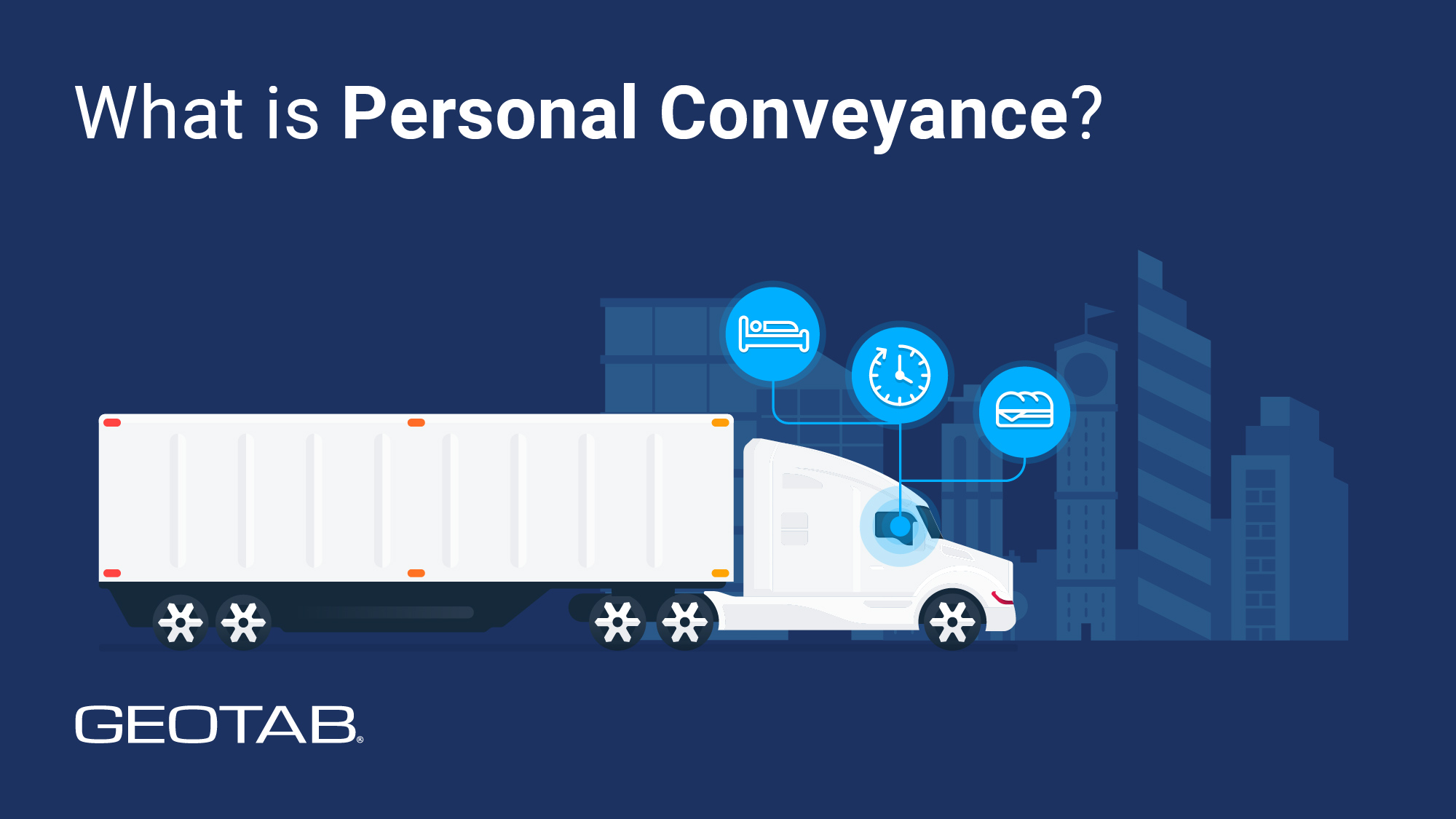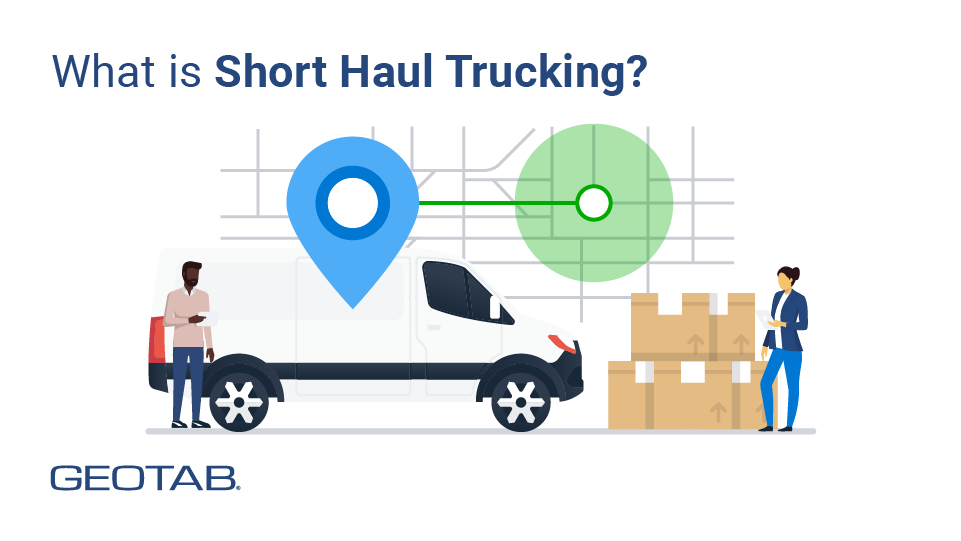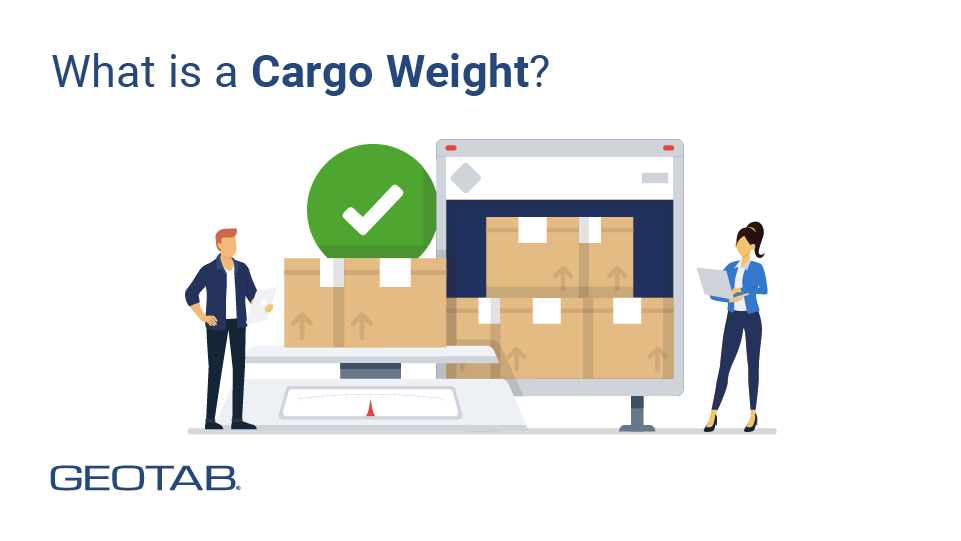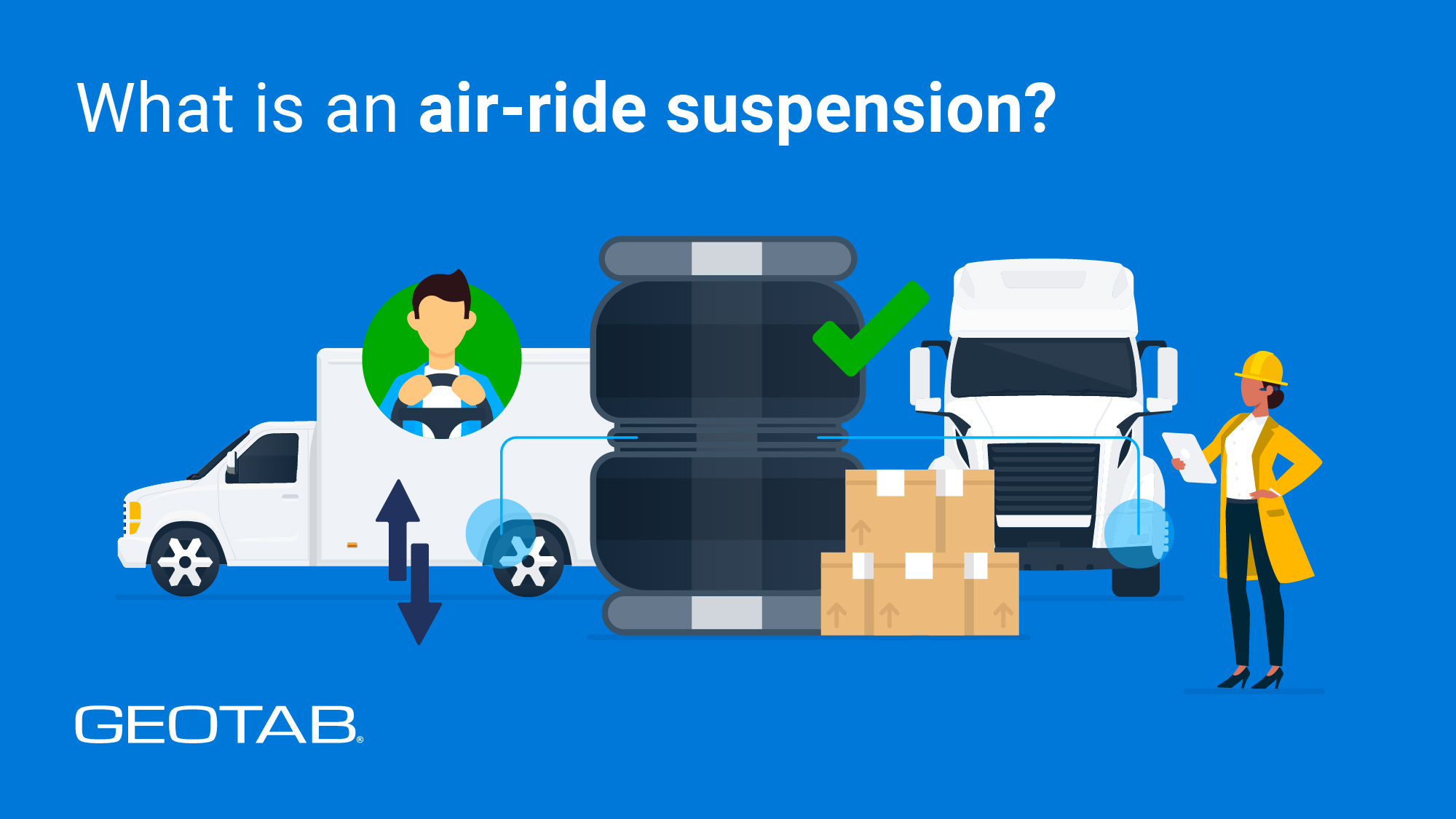What is personal conveyance? Key rules and best practices for drivers
November 13, 2024
•6 minute read

Key Insights
- Personal Conveyance (PC) refers to the use of a commercial motor vehicle (CMV) for personal reasons while the driver is off-duty.
What is personal conveyance?
Personal Conveyance (PC) refers to the use of a commercial motor vehicle (CMV) for personal reasons while the driver is off-duty. The Federal Motor Carrier Safety Administration (FMCSA) regulates personal conveyance, which allows drivers to use commercial motor vehicles for non-business travel without affecting their Hours of Service (HOS) compliance. For fleet managers, understanding and implementing PC policies is essential for both regulatory compliance and maximizing driver flexibility. In this post, you will learn key rules and best practices for personal conveyance to help your fleet keep drivers safe and avoid legal liability.
Regulatory guidelines from the FMCSA
Fleet managers must make sure their drivers understand and follow FMCSA guidelines. These guidelines state that any travel that furthers the business—such as driving to pick up a load or fueling a vehicle — is not eligible as PC. Per these regulations, PC travel does not interrupt a driver’s on-duty cycle or rest hours. This distinction is crucial for maintaining legal compliance and allows drivers to reach a rest area or lodging after loading hours without violating HOS rules.
Failing to follow PC regulations can carry serious legal repercussions for both drivers and fleet operators, including:
- HOS violations and fines: Incorrectly logged PC time may lead to HOS violations, which can result in fines or penalties during regulatory inspections.
- Impact on fleet compliance scores: Frequent PC misuse can negatively impact a fleet’s safety score, affecting carrier reputation, insurance rates and audit risk.
- Potential liability in accidents: If a driver misuses PC and is involved in a collision, it can raise liability concerns—especially if authorities find the driver was advancing a business interest while claiming PC.
Fleet managers can mitigate these risks by training drivers on correct PC use, implementing oversight measures and reinforcing the serious consequences of misuse. In the following sections, we will review these best practices.
Understanding off-duty time
To be eligible for personal conveyance, a driver must be off-duty. This means they aren’t engaged in tasks that advance the carrier's commercial interests. Off-duty time must be completely free of work responsibilities like vehicle inspection, paperwork or waiting for a load. Off-duty time is important in fleet operations because it gives drivers personal flexibility to drive to safe parking or amenities. To help maintain compliance, fleet managers should require drivers to document PC status correctly and differentiate it from HOS.
Who can use personal conveyance?
While personal conveyance rules apply broadly to commercial drivers in the U.S., PC use depends on each carrier’s policies. Drivers should learn the PC rules for their carriers, and fleet managers must clarify to drivers that PC is a privilege that must be used responsibly rather than an entitlement. This approach not only aids in compliance but also minimizes the risk of misuse that can lead to legal consequences.
Examples of appropriate use of personal conveyance
The FMCSA encourages commercial drivers not to “overthink” personal conveyance time and provides examples to guide drivers on what qualifies as appropriate personal conveyance, including:
- Commuting to lodging: After completing a delivery, a driver may use PC to reach nearby lodging or a safe, legal parking location.
- Accessing food or amenities: Drivers can use PC to travel to restaurants, grocery stores or other facilities for personal needs while off-duty.
- Moving away from congestion: If parked in an unsafe or prohibited area, drivers may use PC to find safer parking and maintain their safety and compliance.
Examples of inappropriate use of personal conveyance
The most important PC rule drivers and fleet managers must understand is that any movement that advances the carrier’s business interest does not qualify as personal conveyance. Common examples of inappropriate PC use include:
- Driving toward the next load: Drivers may not use PC to reach or drive nearer a pickup location for the next load, even if off-duty, as this counts as advancing business interest.
- Returning to the carrier's terminal: Moving toward the terminal or any business-related destination, even off-duty, does not qualify as PC.
- Pulling an empty trailer or bobtailing: Driving without a trailer does not guarantee compliance with PC rules, which are based on the purpose of moving a vehicle, not the vehicle’s load (or lack thereof).
- Traveling for maintenance or repairs: Any travel involving vehicle maintenance, repairs or inspections is considered part of on-duty operations and does not qualify as PC.
Distance and time limitations for personal conveyance
The FMCSA does not specify mileage or time limitations for PC, but it mandates that each instance of personal conveyance be reasonable and justifiable.. Fleets can set their restrictions to align with company policies, balancing driver needs with operational compliance. For example, some fleets limit PC usage to a certain number of miles or impose time caps to avoid lengthy, ambiguous travel. This simplifies policy compliance and sets clear expectations to help drivers plan their off-duty activities within approved boundaries.
Best practices for compliance with personal conveyance rules
Effective fleet management requires clear policies and communication on PC usage to protect fleets from legal complications, preserve driver HOS records, and strengthen compliance with FMCSA regulations. Here are four best practices for PC compliance:
- Provide clear PC training and documentation: Regularly train drivers on what constitutes PC, using specific examples and scenarios to simplify compliance.
- Establish consistent record-keeping: Encourage drivers to log PC time accurately by noting the purpose and nature of each instance.
- Set company-specific guidelines: Fleets may want to limit PC distance or time, as this provides internal clarity to avoid regulatory scrutiny.
- Use telematics and electronic logging devices (ELDs) for monitoring: Many ELDs have features that automatically distinguish PC time, making it easier for drivers to log PC time and managers to monitor and verify usage.
Importance of having a motor carrier policy
A well-defined motor carrier policy on personal conveyance is essential for effective fleet management. A motor carrier policy helps all drivers understand when PC is appropriate and how it must be documented. Fleet managers should regularly review and update their motor carrier policy to follow new regulatory changes and industry best practices. Key benefits of a motor carrier policy include:
- Clarity for drivers: A clear policy defines acceptable PC use, provides specific examples and addresses gray areas, such as time and distance limitations.
- Risk mitigation: By setting rules that align with FMCSA guidelines, fleets reduce the risk of violations or misuse and, therefore, avoid fines or other legal consequences.
- Enhanced safety and compliance: A structured PC policy promotes safer, more responsible driving habits that protect drivers and the fleet’s reputation.
Common misconceptions about personal conveyance
There are several misconceptions surrounding personal conveyance that can lead to unintentional misuse. Here are a few common myths:
- Myth: PC allows unlimited miles and time — While the FMCSA does not specify exact limits, drivers are still expected to use PC within reasonable bounds. Excessive use without justification may lead to regulatory scrutiny.
- Myth: Drivers can use PC to avoid hours of service violations – PC cannot be used to evade HOS limits. Drivers must always adhere to HOS regulations.
- Myth: All off-duty travel qualifies as PC — Not all off-duty travel counts as personal conveyance. Any movement that advances a business purpose, such as driving a vehicle closer to the next load, is not eligible as PC.
Differences between U.S. and Canadian PC regulations
Personal conveyance regulations differ between the United States and Canada, impacting cross-border fleets. For fleets operating internationally, staying informed on both countries' regulations is important to avoid cross-border compliance issues and allow seamless operation. Some key contrasts include:
- Canadian daily time limit on PC: In Canada, drivers have a cap of 75 kilometers (about 46 miles) per day for personal conveyance and the driver must record the odometer reading at the start and finish of PC. The U.S. does not specify a distance limit.
- Documentation requirements: Canadian regulations require drivers to log PC details explicitly, while in the U.S., ELDs or telematics often handle this automatically (Making notes on the purpose of PC is still recommended).
- Trailer regulations: Canada requires commercial vehicles to be unloaded and any trailer to be unhitched to use PC, while the U.S. does not require this.
The ELD mandate and personal conveyance
The electronic logging device mandate plays a significant role in tracking personal conveyance. With ELDs in place, fleets and drivers have digital assistance to log and categorize time spent on PC accurately. This simplifies compliance with FMCSA rules because ELDs automatically record time and distance traveled, making monitoring PC use easier for fleet managers. Benefits of using ELDs to manage PC include:
- Automatic logging: ELDs reduce human error in documenting PC. Drivers can select PC mode, and the device will automatically log the information correctly.
- Enhanced oversight: Fleet managers gain real-time visibility into PC activities, enabling quick identification of potential misuse through automated alerts.
- Efficient recordkeeping: ELDs store detailed records of PC use, making it easier to respond to audits or regulatory checks.
Ensuring driver safety during personal conveyance
Personal conveyance offers drivers additional flexibility, but fleet managers should prioritize safety to help reduce overuse or unsafe practices. Key safety considerations include:
- Setting practical limits: While the FMCSA does not impose a distance limit, fleet managers may set a reasonable cap on PC mileage to help reduce driver fatigue.
- Encouraging driver rest: Drivers should only use PC when they’re well-rested and should avoid long, stressful drives, especially after a full shift.
- Promoting safe parking locations: When using PC to find parking, drivers should be encouraged to select locations that are safe and compliant with local laws.
Frequently Asked Questions
A driver is considered off-duty during personal conveyance if they are not performing work-related tasks or engaged in activities that further the business, such as preparing for the next dispatch. PC requires the driver to be relieved of all work responsibilities, and their actions must align with FMCSA’s definition of off-duty.
Personal conveyance allows drivers to use their commercial vehicles for personal activities, offering flexibility to find safe parking, access amenities, or handle personal needs without impacting HOS compliance. For fleet managers, enabling appropriate PC use supports driver morale and can prevent safety or HOS issues.
Drivers may use personal conveyance to reach nearby lodging, access food or amenities or find safer parking as long as they are off-duty and not advancing a business purpose. Each PC use must align with FMCSA guidelines and any specific company policies.
No, fueling a CMV is considered a work-related activity and does not qualify as personal conveyance. Fuel stops are treated as on-duty time, directly related to the vehicle’s operational readiness for business use.
No, driving for vehicle maintenance, repairs or inspections is classified as on-duty activity, as these actions contribute to the vehicle’s business readiness. Such travel must be logged as part of the driver’s on-duty time.
The FMCSA does not specify a time or distance limit for personal conveyance, but PC travel must be reasonable and documented. However, some fleets set distance limits to help with compliance and to help reduce overuse or driver fatigue.
Yes, drivers may use personal conveyance to return home if they are off-duty and not moving toward a business-related location or load pickup. This is particularly useful for drivers who complete their last delivery and wish to return home rather than staying at a nearby facility.
No, time spent on personal conveyance does not count against the 14-hour on-duty limit, as it is considered off-duty time. However, drivers must log their PC time accurately, as any misuse or incorrect logging could lead to HOS compliance issues.
Table of Contents
- What is personal conveyance?
- Regulatory guidelines from the FMCSA
- Understanding off-duty time
- Who can use personal conveyance?
- Examples of appropriate use of personal conveyance
- Examples of inappropriate use of personal conveyance
- Distance and time limitations for personal conveyance
- Best practices for compliance with personal conveyance rules
- Importance of having a motor carrier policy
- Common misconceptions about personal conveyance
- Differences between U.S. and Canadian PC regulations
- The ELD mandate and personal conveyance
- Ensuring driver safety during personal conveyance
Other Stories

March 20, 2025
4 minute read

March 20, 2025
3 minute read

What is an air-ride suspension? The pros and cons
March 13, 2025
2 minute read